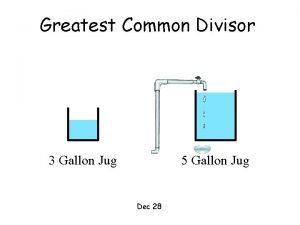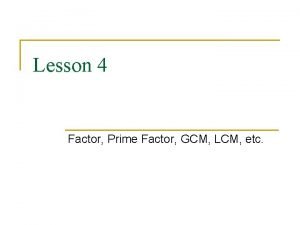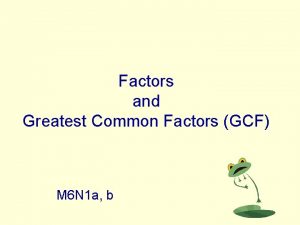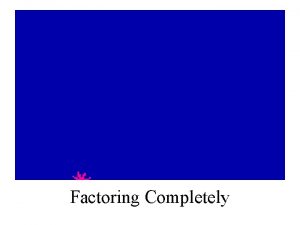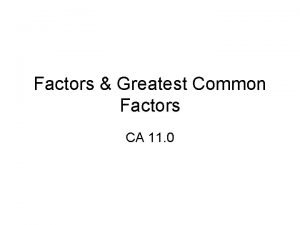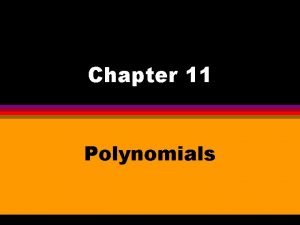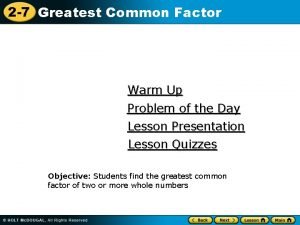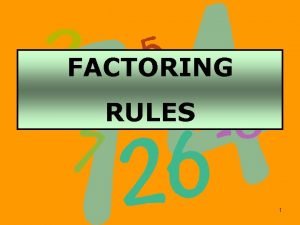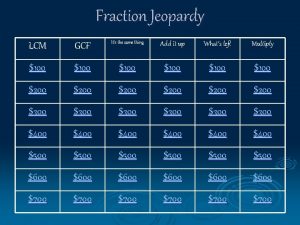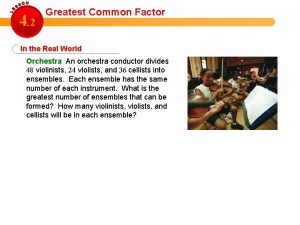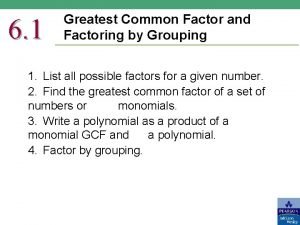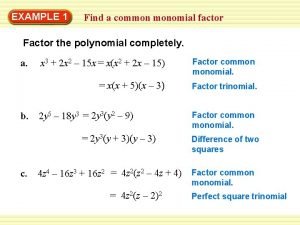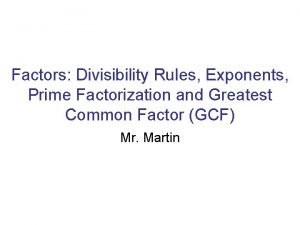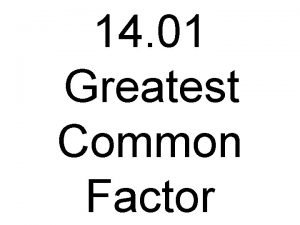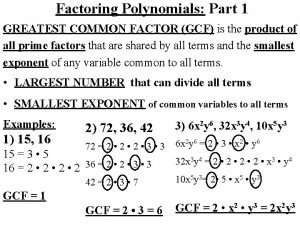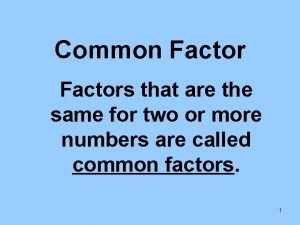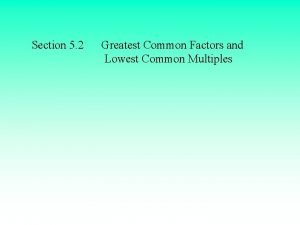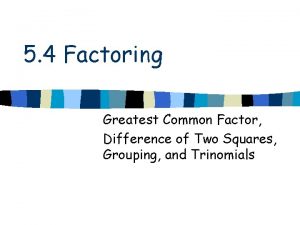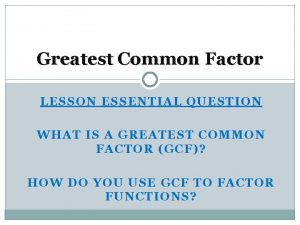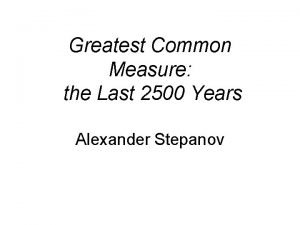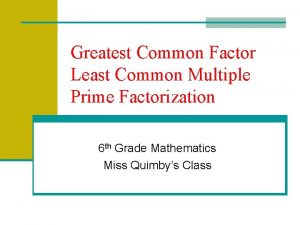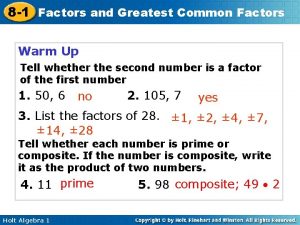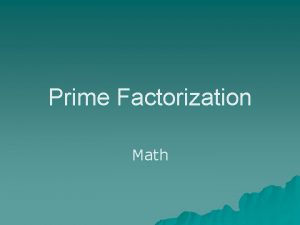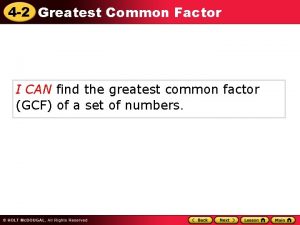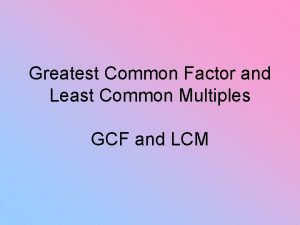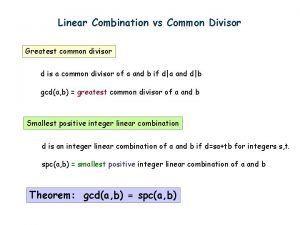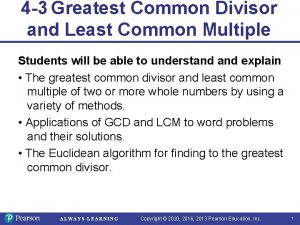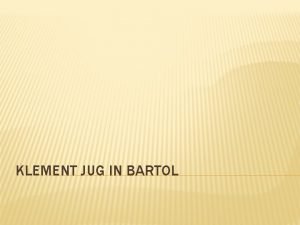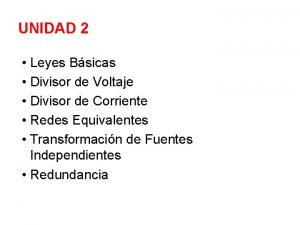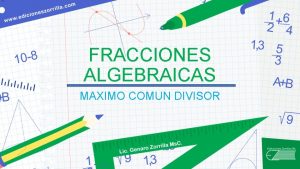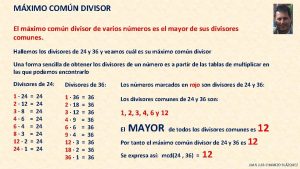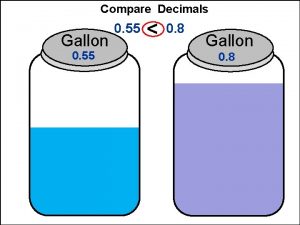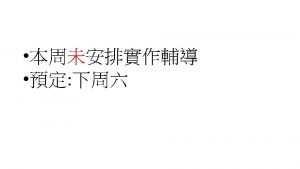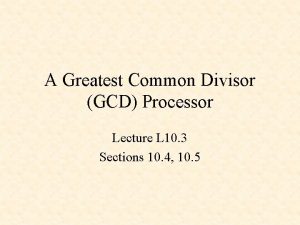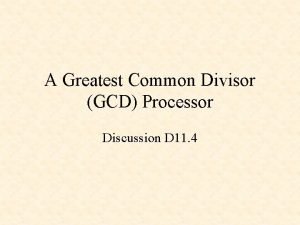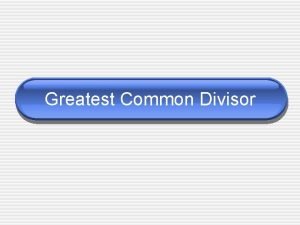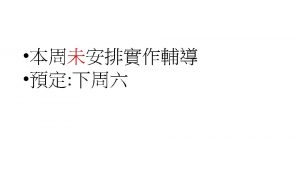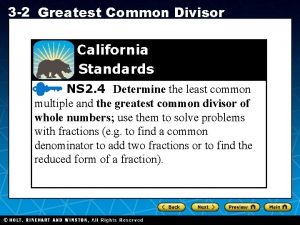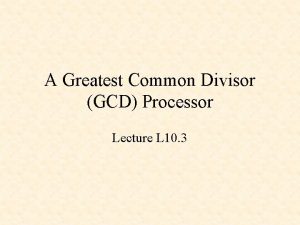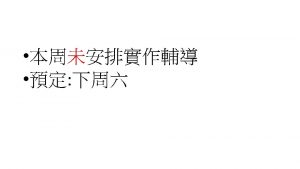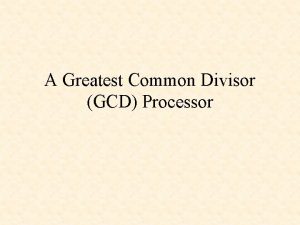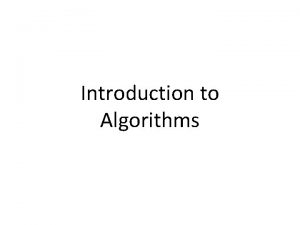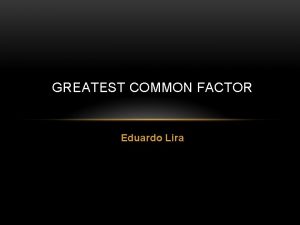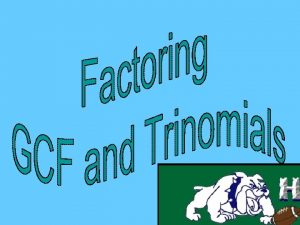Greatest Common Divisor 3 Gallon Jug 5 Gallon













































- Slides: 45

Greatest Common Divisor 3 Gallon Jug 5 Gallon Jug Dec 28

This Lecture • Quotient remainder theorem • Greatest common divisor & Euclidean algorithm • Linear combination and GCD, extended Euclidean algorithm • Prime factorization and other applications

The Quotient-Remainder Theorem For b > 0 and any a, there are unique numbers q : : = quotient(a, b), r : : = remainder(a, b), such that a = qb + r We also say and q = a div b 0 r < b. and r = a mod b. When b=2, this says that for any a, there is a unique q such that a=2 q or a=2 q+1. When b=3, this says that for any a, there is a unique q such that a=3 q or a=3 q+1 or a=3 q+2.

The Quotient-Remainder Theorem For b > 0 and any a, there are unique numbers q : : = quotient(a, b), r : : = remainder(a, b), such that a = qb + r and 0 r < b. Given any b, we can divide the integers into many blocks of b numbers. For any a, there is a unique “position” for a in this line. q = the block where a is in -b 0 b 2 b r = the offset in this block kb a (k+1)b Clearly, given a and b, q and r are uniquely defined.

This Lecture • Quotient remainder theorem • Greatest common divisor & Euclidean algorithm • Linear combination and GCD, extended Euclidean algorithm • Prime factorization and other applications

Common Divisors c is a common divisor of a and b means c|a and c|b. gcd(a, b) : : = the greatest common divisor of a and b. Say a=8, b=10, then 1, 2 are common divisors, and gcd(8, 10)=2. Say a=10, b=30, then 1, 2, 5, 10 are common divisors, and gcd(10, 30)=10. Say a=3, b=11, then the only common divisor is 1, and gcd(3, 11)=1. Claim. If p is prime, and p does not divide a, then gcd(p, a) = 1.

Greatest Common Divisors Given a and b, how to compute gcd(a, b)? Can try every number, but can we do it more efficiently? Let’s say a>b. 1. If a=kb, then gcd(a, b)=b, and we are done. 2. Otherwise, by the Division Theorem, a = qb + r for r>0.

Greatest Common Divisors Let’s say a>b. 1. If a=kb, then gcd(a, b)=b, and we are done. 2. Otherwise, by the Division Theorem, a = qb + r for r>0. a=12, b=8 => 12 = 8 + 4 gcd(12, 8) = 4 gcd(8, 4) = 4 a=21, b=9 => 21 = 2 x 9 + 3 gcd(21, 9) = 3 gcd(9, 3) = 3 a=99, b=27 => 99 = 3 x 27 + 18 gcd(99, 27) = 9 gcd(27, 18) = 9 Euclid: gcd(a, b) = gcd(b, r)!

Euclid’s GCD Algorithm a = qb + r Euclid: gcd(a, b) = gcd(b, r) gcd(a, b) if b = 0, then answer = a. else write a = qb + r answer = gcd(b, r)

Example 1 gcd(a, b) if b = 0, then answer = a. else write a = qb + r answer = gcd(b, r) GCD(102, 70) 102 = 70 + 32 = GCD(70, 32) 70 = 2 x 32 + 6 = GCD(32, 6) 32 = 5 x 6 + 2 = GCD(6, 2) 6 = 3 x 2 + 0 = GCD(2, 0) Return value: 2.

Example 2 gcd(a, b) if b = 0, then answer = a. else write a = qb + r answer = gcd(b, r) GCD(252, 189) = GCD(189, 63) 252 = 1 x 189 + 63 189 = 3 x 63 + 0 = GCD(63, 0) Return value: 63.

Example 3 gcd(a, b) if b = 0, then answer = a. else write a = qb + r answer = gcd(b, r) GCD(662, 414) 662 = 1 x 414 + 248 = GCD(414, 248) 414 = 1 x 248 + 166 = GCD(248, 166) 248 = 1 x 166 + 82 = GCD(166, 82) 166 = 2 x 82 + 2 = GCD(82, 2) 82 = 41 x 2 + 0 = GCD(2, 0) Return value: 2.

Correctness of Euclid’s GCD Algorithm a = qb + r Euclid: gcd(a, b) = gcd(b, r) When r = 0: Then gcd(b, r) = gcd(b, 0) = b since every number divides 0. But a = qb so gcd(a, b) = b = gcd(b, r), and we are done.

Correctness of Euclid’s GCD Algorithm a = qb + r Euclid: gcd(a, b) = gcd(b, r) When r > 0: Let d be a common divisor of b, r Þ b = k 1 d and r = k 2 d for some k 1, k 2. Þ a = qb + r = qk 1 d + k 2 d = (qk 1 + k 2)d => d is a divisor of a Let d be a common divisor of a, b Þ a = k 3 d and b = k 1 d for some k 1, k 3. Þ r = a – qb = k 3 d – qk 1 d = (k 3 – qk 1)d => d is a divisor of r So d is a common factor of a, b iff d is a common factor of b, r Þ d = gcd(a, b) iff d = gcd(b, r)

How fast is Euclid’s GCD Algorithm? Naive algorithm: try every number, Then the running time is about 2 b iterations. Euclid’s algorithm: In two iterations, the b is decreased by half. (why? ) Then the running time is about 2 log(b) iterations. Exponentially faster!!

This Lecture • Quotient remainder theorem • Greatest common divisor & Euclidean algorithm • Linear combination and GCD, extended Euclidean algorithm • Prime factorization and other applications

Linear Combination vs Common Divisor Greatest common divisor d is a common divisor of a and b if d|a and d|b gcd(a, b) = greatest common divisor of a and b Smallest positive integer linear combination d is an integer linear combination of a and b if d=sa+tb for integers s, t. spc(a, b) = smallest positive integer linear combination of a and b Theorem: gcd(a, b) = spc(a, b)

Linear Combination vs Common Divisor Theorem: gcd(a, b) = spc(a, b) For example, the greatest common divisor of 52 and 44 is 4. And 4 is a linear combination of 52 and 44: 6 · 52 + (− 7) · 44 = 4 Furthermore, no linear combination of 52 and 44 is equal to a smaller positive integer. To prove theorem, we will prove: gcd(a, b) <= spc(a, b) gcd(a, b) | spc(a, b) <= gcd(a, b) spc(a, b) is a common divisor of a and b

GCD <= SPC 3. If d | a and d | b, then d | sa + tb for all s and t. Proof of (3) d | a => a = dk 1 d | b => b = dk 2 sa + tb = sdk 1 + tdk 2 = d(sk 1 + tk 2) => d|(sa+tb) GCD | SPC Let d = gcd(a, b). By definition, d | a and d | b. Let f = spc(a, b) = sa+tb By (3), d | f. This implies d <= f. That is gcd(a, b) <= spc(a, b).

SPC <= GCD We will prove that spc(a, b) is actually a common divisor of a and b. First, show that spc(a, b) | a. 1. Suppose, by way of contradiction, that spc(a, b) does not divide a. 2. Then, by the Division Theorem, 3. a = q x spc(a, b) + r and spc(a, b) > r > 0 4. Let spc(a, b) = sa + tb. 5. So r = a – q x spc(a, b) = a – q x (sa + tb) = (1 -qs)a + qtb. 6. Thus r is an integer linear combination of a and b, and spc(a, b) > r. 7. This contradicts the definition of spc(a, b), and so r must be zero. Similarly, spa(a, b) | b. So, spc(a, b) is a common divisor of a and b, thus by definition spc(a, b) <= gcd(a, b).

Extended GCD Algorithm How can we write gcd(a, b) as an integer linear combination? This can be done by extending the Euclidean’s algorithm. Example: a = 259, b=70 259 = 3· 70 + 49 49 = a – 3 b 70 = 1· 49 + 21 21 = 70 - 49 21 = b – (a-3 b) = -a+4 b 49 = 2· 21 + 7 7 = 49 - 2· 21 7 = (a-3 b) – 2(-a+4 b) = 3 a – 11 b 21 = 7· 3 + 0 done, gcd = 7

Extended GCD Algorithm Example: a = 899, b=493 899 = 1· 493 + 406 493 = 1· 406 + 87 so 406 = a - b so 87 = 493 – 406 = b – (a-b) = -a + 2 b 406 = 4· 87 + 58 so 58 = 406 - 4· 87 = (a-b) – 4(-a+2 b) = 5 a - 9 b 87 = 1· 58 + 29 so 29 = 87 – 1· 58 = (-a+2 b) - (5 a-9 b) = -6 a + 11 b 58 = 2· 29 + 0 done, gcd = 29

This Lecture • Quotient remainder theorem • Greatest common divisor & Euclidean algorithm • Linear combination and GCD, extended Euclidean algorithm • Prime factorization and other applications

Application of the Theorem: gcd(a, b) = spc(a, b) Why is theorem useful? (1) we can now “write down” gcd(a, b) as some concrete equation, (i. e. gcd(a, b) = sa+tb for some integers s and t), and this allows us to reason about gcd(a, b) much easier. (2) If we can find integers s and t so that sa+tb=c, then we can conclude that gcd(a, b) <= c. In particular, if c=1, then we can conclude that gcd(a, b)=1.

Prime Divisibility Theorem: gcd(a, b) = spc(a, b) Lemma: p prime and p|a·b implies p|a or p|b. pf: say p does not divide a. so gcd(p, a)=1. So by the Theorem, there exist s and t such that sa + tp =1 (sa)b + (tp)b = b p|ab p|p Hence p|b Cor : If p is prime, and p| a 1·a 2···am then p|ai for some i.

Fundamental Theorem of Arithmetic Every integer, n>1, has a unique factorization into primes: p 0 ≤ p 1 ≤ ··· ≤ pk p 0 p 1 ··· pk = n Example: 61394323221 = 3· 3· 3· 7· 11· 37· 37· 53

Unique Factorization Theorem: There is a unique factorization. proof: suppose, by contradiction, that there are numbers with two different factorization. By the well-ordering principle, we choose the smallest such n >1: n = p 1·p 2···pk = q 1·q 2···qm Since n is smallest, we must have that pi qj all i, j (Otherwise, we can obtain a smaller counterexample. ) Since p 1|n = q 1·q 2···qm, so by Cor. , p 1|qi for some i. contradiction! Since both p 1 = qi are prime numbers, we must have p 1 = qi.

Application of the Theorem: gcd(a, b) = spc(a, b) Lemma. If gcd(a, b)=1 and gcd(a, c)=1, then gcd(a, bc)=1. By the Theorem, there exist s, t, u, v such that sa + tb = 1 ua + vc = 1 Multiplying, we have (sa + tb)(ua + vc) = 1 Þ saua + savc + tbua + tbvc = 1 Þ (sau + svc + tbu)a + (tv)bc = 1 By the Theorem, since spc(a, bc)=1, we have gcd(a, bc)=1

Die Hard Simon says: On the fountain, there should be 2 jugs, do you see them? A 5 -gallon and a 3 -gallon. Fill one of the jugs with exactly 4 gallons of water and place it on the scale and the timer will stop. You must be precise; one ounce more or less will result in detonation. If you're still alive in 5 minutes, we'll speak.

Die Hard Bruce: Wait, wait a second. I don’t get it. Do you get it? Samuel: No. Bruce: Get the jugs. Obviously, we can’t fill the 3 -gallon jug with 4 gallons of water. Samuel: Obviously. Bruce: All right. I know, here we go. We fill the 3 -gallon jug exactly to the top, right? Samuel: Uh-huh. Bruce: Okay, now we pour this 3 gallons into the 5 -gallon jug, giving us exactly 3 gallons in the 5 -gallon jug, right? Samuel: Right, then what? Bruce: All right. We take the 3 -gallon jug and fill it a third of the way. . . Samuel: No! He said, “Be precise. ” Exactly 4 gallons. Bruce: Sh - -. Every cop within 50 miles is running his a - - off and I’m out here playing kids games in the park. Samuel: Hey, you want to focus on the problem at hand?

Die Hard Start with empty jugs: (0, 0) Fill the big jug: (0, 5) 3 Gallon Jug 5 Gallon Jug

Die Hard Pour from big to little: (3, 2) 3 Gallon Jug 5 Gallon Jug

Die Hard Empty the little: (0, 2) 3 Gallon Jug 5 Gallon Jug

Die Hard Pour from big to little: (2, 0) 3 Gallon Jug 5 Gallon Jug

Die Hard Fill the big jug: (2, 5) 3 Gallon Jug 5 Gallon Jug

Die Hard Pour from big to little: (3, 4) 3 Gallon Jug 5 Gallon Jug Done!!

Die Hard What if you have a 9 gallon jug instead? 3 Gallon Jug 5 Gallon Jug 9 Gallon Jug Can you do it? Can you prove it?

Die Hard Supplies: 3 Gallon Jug Water 9 Gallon Jug

Invariant Method Invariant: the number of gallons in each jug is a multiple of 3. i. e. , 3|b and 3|l (3 divides b and 3 divides l) Corollary: it is impossible to have exactly 4 gallons in one jug. Bruce Dies!

Generalized Die Hard Can Bruce form 3 gallons using 21 and 26 -gallon jugs? This question is not so easy to answer without number theory.

General Solution for Die Hard Invariant in Die Hard Transition: Suppose that we have water jugs with capacities B and L. Then the amount of water in each jug is always an integer linear combination of B and L. Theorem: gcd(a, b) = spc(a, b) Corollary: Every linear combination of a and b is a multiple of gcd(a, b). Corollary: The amount of water in each jug is a multiple of gcd(a, b).

General Solution for Die Hard Corollary: The amount of water in each jug is a multiple of gcd(a, b). Given jug of 3 and jug of 9, is it possible to have exactly 4 gallons in one jug? NO, because gcd(3, 9)=3, and 4 is not a multiple of 3. Given jug of 21 and jug of 26, is it possible to have exactly 3 gallons in one jug? gcd(21, 26)=1, and 3 is a multiple of 1, so this possibility has not been ruled out yet. Theorem. Given water jugs of capacity a and b, it is possible to have exactly k gallons in one jug if and only if k is a multiple of gcd(a, b).

General Solution for Die Hard Theorem. Given water jugs of capacity a and b, it is possible to have exactly k gallons in one jug if and only if k is a multiple of gcd(a, b). Given jug of 21 and jug of 26, is it possible to have exactly 3 gallons in one jug? gcd(21, 26) = 1 Þ 5 x 21 – 4 x 26 = 1 Þ 15 x 21 – 12 x 26 = 3 Repeat 15 times: 1. Fill the 21 -gallon jug. 2. Pour all the water in the 21 -gallon jug into the 26 -gallon jug. Whenever the 26 -gallon jug becomes full, empty it out.

General Solution for Die Hard 15 x 21 – 12 x 26 = 3 Repeat 15 times: 1. Fill the 21 -gallon jug. 2. Pour all the water in the 21 -gallon jug into the 26 -gallon jug. Whenever the 26 -gallon jug becomes full, empty it out. 1. There must be exactly 3 gallons left after this process. 2. Totally we have filled 15 x 21 gallons. 3. We pour out some multiple t of 26 gallons. 4. The 26 gallon jug can only hold somewhere between 0 and 26. 5. So t must be equal to 12. 6. And there are exactly 3 gallons left.

General Solution for Die Hard Given two jugs with capacity A and B with A < B, the target is C. If gcd(A, B) does not divide C, then it is impossible. Otherwise, compute C = s. A + t. B. Repeat s times: 1. Fill the A-gallon jug. 2. Pour all the water in the A-gallon jug into the B-gallon jug. Whenever the B-gallon jug becomes full, empty it out. The B-gallon jug will be emptied exactly t times. After that, there will be exactly C gallons in the B-gallon jug.
 Gcd
Gcd Gcm lcm
Gcm lcm Gcf of 48 and 36
Gcf of 48 and 36 Us gallon and uk gallon
Us gallon and uk gallon Lcm of 48 and 60
Lcm of 48 and 60 Common factors of 20 and 24
Common factors of 20 and 24 Greatest common factor of 19
Greatest common factor of 19 Greatest prime factor of 77
Greatest prime factor of 77 Greatest common factor of 15 and 35
Greatest common factor of 15 and 35 Highest common factor
Highest common factor Hcf of 30
Hcf of 30 Greatest common monomial factor of 5a3+a3b
Greatest common monomial factor of 5a3+a3b Lesson 1 factoring using the greatest common factor
Lesson 1 factoring using the greatest common factor List factors of 54
List factors of 54 Factoring problems
Factoring problems Greatest common factor of 7 and 9
Greatest common factor of 7 and 9 7-1 factors and greatest common factors
7-1 factors and greatest common factors Highest common factor
Highest common factor Factors of 40 that are perfect squares
Factors of 40 that are perfect squares What is factored form
What is factored form Example of polynomial with common monomial factor
Example of polynomial with common monomial factor Factors of 36 and 24
Factors of 36 and 24 Greatest common factor prime factorization
Greatest common factor prime factorization What is the greatest common factor of 42 and 84
What is the greatest common factor of 42 and 84 Factors of 54
Factors of 54 Factoring problems
Factoring problems Gcf of 27 and 36
Gcf of 27 and 36 Lesson 2-1 greatest common factor
Lesson 2-1 greatest common factor Greatest common factor of 18 and 30
Greatest common factor of 18 and 30 Lowest common factor
Lowest common factor Factor out the greatest common factor
Factor out the greatest common factor Find the common factor of 12 and 24
Find the common factor of 12 and 24 Gcf of 90 and 72
Gcf of 90 and 72 Factors of 96
Factors of 96 Greatest common measure
Greatest common measure Factors of 48 and 40
Factors of 48 and 40 Factor by gcf
Factor by gcf Prime factor of 56
Prime factor of 56 What is the greatest common factor of 18, 9, and 45?
What is the greatest common factor of 18, 9, and 45? Lesson 1 factoring using the greatest common factor
Lesson 1 factoring using the greatest common factor Greatest common factor of 60
Greatest common factor of 60 Factor 72
Factor 72 Gcf of 18 and 36
Gcf of 18 and 36 Prime factor
Prime factor How to do greatest common factor
How to do greatest common factor Lcm of 26 32
Lcm of 26 32
